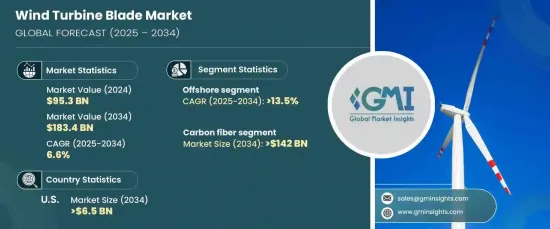PUBLISHER: Global Market Insights Inc. | PRODUCT CODE: 1666609

PUBLISHER: Global Market Insights Inc. | PRODUCT CODE: 1666609
Wind Turbine Blade Market Opportunity, Growth Drivers, Industry Trend Analysis, and Forecast 2025 - 2034
The Global Wind Turbine Blade Market, valued at USD 95.3 billion in 2024, is expected to experience robust growth, with a projected CAGR of 6.6% from 2025 to 2034. Wind turbine blades play a crucial role in harnessing kinetic energy from the wind and converting it into mechanical energy to generate electricity. Available in various sizes and lengths based on the turbine's capacity and design, the efficiency of these blades directly impacts the performance and energy output of the turbine.

A global shift toward renewable energy is gaining momentum, driven by an increasing demand for reliable and sustainable power sources. This transition is expected to accelerate the deployment of wind energy projects worldwide. The growing focus on offshore wind farms, particularly in regions with established energy markets, is expected to significantly contribute to market expansion. With government policies supporting offshore wind development and ongoing innovations in wind blade design, the demand for advanced wind turbine blades will continue to rise.
| Market Scope | |
|---|---|
| Start Year | 2024 |
| Forecast Year | 2025-2034 |
| Start Value | $95.3 Billion |
| Forecast Value | $183.4 Billion |
| CAGR | 6.6% |
The carbon fiber segment is set to lead the market, with a forecasted value of USD 142 billion by 2034. Carbon fiber's exceptional strength-to-weight ratio allows for the design of lighter and more efficient blades. This reduces the load on turbine components, enhancing overall performance. Additionally, carbon fiber's increased stiffness improves blade aerodynamics, offering better control over deflection and deformation under varying wind conditions. These benefits are driving the growing demand for carbon fiber-based wind turbine blades.
The offshore wind energy segment is anticipated to grow at an impressive CAGR of 13.5% through 2034. Offshore wind farms, which face unique challenges such as high wind speeds, saltwater exposure, and potential icing, require larger and more durable turbine blades. These specialized blades are designed with advanced aerodynamics to maximize energy capture even under harsh maritime conditions, supporting the rapid growth of offshore wind energy projects globally.
The U.S. wind turbine blade market is projected to reach USD 6.5 billion by 2034. Factors such as rapid urbanization, industrial expansion, and rising energy demands are driving significant investments in both onshore and offshore wind projects. Technological advancements, including the development of lightweight materials and innovations in predictive maintenance, are expected to improve the performance and longevity of wind turbine blades. As the number of new wind energy projects continues to increase, these innovations will enhance turbine efficiency and extend their operational lifespan.
Table of Contents
Chapter 1 Methodology & Scope
- 1.1 Research design
- 1.2 Base estimates & calculations
- 1.3 Forecast model
- 1.4 Primary research & validation
- 1.4.1 Primary sources
- 1.4.2 Data mining sources
- 1.5 Market definitions
Chapter 2 Executive Summary
- 2.1 Industry synopsis, 2021 – 2034
Chapter 3 Industry Insights
- 3.1 Industry ecosystem
- 3.2 Regulatory landscape
- 3.3 Industry impact forces
- 3.3.1 Growth drivers
- 3.3.2 Industry pitfalls & challenges
- 3.4 Growth potential analysis
- 3.5 Porter's analysis
- 3.5.1 Bargaining power of suppliers
- 3.5.2 Bargaining power of buyers
- 3.5.3 Threat of new entrants
- 3.5.4 Threat of substitutes
- 3.6 PESTEL analysis
Chapter 4 Competitive landscape, 2024
- 4.1 Introduction
- 4.2 Strategic dashboard
- 4.3 Innovation & technology landscape
Chapter 5 Market Size and Forecast, By Material, 2021 – 2034 (USD Million)
- 5.1 Key trends
- 5.2 Carbon fiber
- 5.3 Glass fiber
Chapter 6 Market Size and Forecast, By Application, 2021 – 2034 (USD Million)
- 6.1 Key trends
- 6.2 Onshore
- 6.3 Offshore
Chapter 7 Market Size and Forecast, By Capacity, 2021 – 2034 (USD Million)
- 7.1 Key trends
- 7.2 < 3 MW
- 7.3 3 - 5 MW
- 7.4 > 5 MW
Chapter 8 Market Size and Forecast, By Size, 2021 – 2034 (USD Million & MW)
- 8.1 Key trends
- 8.2 ≤30 m
- 8.3 31 – 60 m
- 8.4 61 – 90 m
- 8.5 ≥ 90 m
Chapter 9 Market Size and Forecast, By Region, 2021 – 2034 (USD Million & MW)
- 9.1 Key trends
- 9.2 North America
- 9.2.1 U.S.
- 9.2.2 Canada
- 9.3 Europe
- 9.3.1 UK
- 9.3.2 Ireland
- 9.3.3 Germany
- 9.3.4 Denmark
- 9.3.5 France
- 9.3.6 Netherlands
- 9.3.7 Belgium
- 9.4 Asia Pacific
- 9.4.1 China
- 9.4.2 Japan
- 9.4.3 South Korea
- 9.4.4 Vietnam
- 9.4.5 Taiwan
- 9.5 Middle East & Africa
- 9.5.1 South Africa
- 9.5.2 Egypt
- 9.6 Latin America
- 9.6.1 Brazil
- 9.6.2 Chile
- 9.6.3 Argentina
Chapter 10 Company Profiles
- 10.1 Acciona S.A.
- 10.2 Aeris Energy
- 10.3 EnBW
- 10.4 Enercon GmbH
- 10.5 Gamesa Corporacion Technologica
- 10.6 Hitachi Power Solutions
- 10.7 LM Wind Power
- 10.8 MFG Wind
- 10.9 Nordex SE
- 10.10 Siemens AG
- 10.11 Sinoma Wind Power Blade Co. Ltd
- 10.12 Suzlon Energy Ltd.
- 10.13 TPI Composites SA
- 10.14 Vestas Wind Systems




